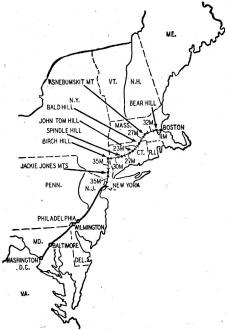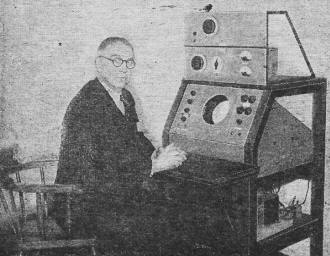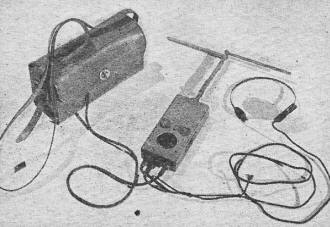|
January 1948 Radio-Craft
 [Table of Contents] [Table of Contents]
Wax nostalgic about and learn from the history of early electronics.
See articles from Radio-Craft,
published 1929 - 1953. All copyrights are hereby acknowledged.
|
In the middle of the last
century, progress in television and radio technology was the focus of public
attention, similar to news of the latest advances in smartphones and
Wi-Fi-connected gadgets are today. Then, it was the installation of microwave
relay networks for long distance telephone and television interconnections as
reported in this 1948 issue of Radio-Craft magazine. Now, media
headlines tell of new 5G cellular network equipment and small cell stations
being installed around the world. New portable pocket radios using a single low
voltage "peanut" vacuum tube or a germanium transistor are today's iPhones,
smartwatches, and IoT-connected appliances. The item that caught my
attention was mention of General electric (GE) issuing warnings that
radar-equipped cargo airplanes should not be used to transport photo-flash
camera bulbs because experiments showed exposure to certain frequencies and
power levels of microwave power could set them off. A 1955 story in Popular
Electronics had a photo of
fluorescent
light bulbs being energized by radar beams. Radar pioneer Sir Edward
Appleton's 1947 Nobel Prize in Physics award is covered as well, along with a
few other interesting items.
Radio-Electronics Monthly Review
Television Programs and telephone conversations are now being
beamed from New York to Boston via microwave. The experimental radio relay system
was formally opened by the Bell System on November 11.

Programs are relayed south of New York by coaxial cable and
north by the microwave relay system.
The two terminal points of the radio relay system are the headquarters building
of the American Telephone and Telegraph Company's Long Lines Department at 32 Avenue
of the Americas in New York and the Bowdoin Square building of the New England Telephone
and Telegraph Company at Boston.
Between terminal points, the microwave beam makes 8 jumps via 7 intermediate
radio relay stations spaced about thirty miles apart. To secure the unobstructed
view between antennas necessary in microwave transmission, the stations are built
on hilltops: Jackie Jones Mountain, 5 miles west of Haverstraw, N. Y.; Birch Hill,
about 3 miles south of Pawling, N. Y.; Spindle Hill, 5 miles north of Waterbury,
Conn.; John Tom Hill, at Glastonbury, Conn.; Bald Hill, 5 miles east of Stafford
Springs, Conn.; Asnebumskit Mountain, 5 miles northwest of Worcester, Mass.; and
Bear Hill at Waltham,. Mass.
On the roof of each radio relay station are 4 antennas, 2 facing along the route
toward New York, 2 facing along the route toward Boston. This allows for 2-way operation
- with one antenna of each pair for transmitting, the other for receiving. The antennas
are ten feet square and incorporate a metal lens capable of focusing the microwave
signals into a sharp beam.
The initial equipment comprises a regular and a spare circuit in each direction.
For operation of these 2 circuits, frequencies in the range 3700 to 4200 megacycles
have been assigned by the Federal Communications Commission. Each circuit carries
a signal band width of about 5 megacycles.
Terminal equipment capable of carrying 240 simultaneous telephone conversations
will be installed for experiment next spring, and it is expected that more channels
will be added later.
Radar may set off photo flashbulbs carried in planes, General
Electric officials warned last month. G-E factories have accordingly been instructed
to ship no more flashbulbs by air.
General Electric said recent experiments have established that the lamps, with
the exception of the primer type, can be ignited by high-energy short-wave electromagnetic
radiation such as is encountered from radar transmitters.

Sir Edward Appleton at one of his pieces of technical equipment.

First of the Citizens Radios is this little two-pound transceiver.
John M. Chamberlain, Civil Aeronautics Board safety-bureau director, stated there
was no indication as yet that small airborne radar sets, like those that must be
installed by February 15 in all passenger planes, are likely to set off the bulbs. These
sets are to be installed to give pilots information about terrain and to warn when
planes come too close.
Presumably even large ground radar transmitters would be effective only over
a range of a few feet.
Radar Pioneer Sir Edward Appleton has been awarded the 1947
Nobel Prize in Physics. His researches have been of great direct importance to communications
as well as radar.
A pioneer investigator of the ionosphere or "radio roof" surrounding the earth,
Sir Edward proved by direct experiment the existence of the layer of ionized atoms
115 miles or so high, present both day and night, which reflects short radio waves
at night.
His later work with radio reflections led directly to radiolocation, as radar
was originally called in England, and his work was one of the underlying factors
of Britain's early radar preparedness which was so decisive in the early stages
of the last war.
The invisible reflecting layers of the ionosphere have been the subject of intensive
research since their existence was proved. Today calculation of their height is
important in determining the best frequencies to use for radio communication over
great distances.
Radar Navigation may be hampered by archaic laws under which
a radar-equipped vessel involved in a collision may be held liable for damages,
Vincent A. Catoggio, New York marine lawyer, warned last month. The inland and international
navigation rules, which were adopted in 1897, provide that a vessel shall slow down
to "moderate speed" in a fog. "Moderate speed" has been interpreted by the courts
to mean a speed that will permit a vessel to stop "within the limits of visibility."
Since one of the most important features of radar is that it permits greater
speed in fog, this ruling would negate much of its value, unless courts would decide
that the visibility of radar could be considered a substitute for the traditional
"rule of sight."
Citizens Radio will soon become an actuality with the help of
printed circuits and new high-frequency tubes. A transceiver already tested and
about to be put in production by Gross Electronics Co. operates on the 460-470 mc
band. It was exhibited by its developer Al Gross, president of the company, at the
recent printed-circuit symposium in Washington.
The radios will be sold in pairs tuned to their own private frequency within
the 460-470 megacycle range, the Citizens Radio Band, thus reducing eaves-dropping.
Each set is a self-contained transmitter and receiver.
They will sell at less than $200 a pair. Volume production eventually should
bring the price down to about $100.
Performance varies under different conditions. On ground level in the city, the
equipment has operated satisfactorily for distances up to four miles. Tests made
in various cities resulted in perfect reception over varied distances among city
blocks. In a ground to plane test, it made good contact between Cleveland Airport
and Sandusky, 60 miles away.
The transmitter and receiver of the civilian walkie-talkie weighs 11 ounces with
antenna, is 6 inches long by about 3 inches wide by 1 1/4 inch thick. With batteries
and leather case, the overall weight of each set is little more than two pounds.
Posted December 11, 2019
|












